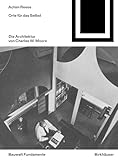Orte für das Selbst: Die Architektur von Charles W. Moore / Achim Reese.
Material type: TextSeries: Bauwelt Fundamente ; 177Publisher: Basel : Birkhäuser, [2024]Copyright date: 2025Description: 1 online resource (272 p.)Content type:
TextSeries: Bauwelt Fundamente ; 177Publisher: Basel : Birkhäuser, [2024]Copyright date: 2025Description: 1 online resource (272 p.)Content type: - 9783035628753
- 9783035628760
- Architekturgeschichte
- Architekturmonographie
- Architekturtheorie
- Fairmont San Jose
- Father of Postmodernism
- MLTW Architekten
- Moore Ruble Yudell
- New Haven House
- Piazza d'Italia
- Postmoderne
- US-amerikanischer Architekt
- architectural history, architectural monograph, architectural theory, Fairmont San Jose, Father of Postmodernism, MLTW Architects, Moore Ruble Yudell, New Haven House, Piazza d'Italia, postmodernism, US-American architect
- online - DeGruyter
- Issued also in print.
| Item type | Current library | Call number | URL | Status | Notes | Barcode | |
|---|---|---|---|---|---|---|---|
 eBook
eBook
|
Biblioteca "Angelicum" Pont. Univ. S.Tommaso d'Aquino Nuvola online | online - DeGruyter (Browse shelf(Opens below)) | Online access | Not for loan (Accesso limitato) | Accesso per gli utenti autorizzati / Access for authorized users | (dgr)9783035628760 |
Frontmatter -- Inhalt -- Einführung -- 1. Mittelpunkte der Welt -- 2. Das Haus als Gegenüber des Selbst -- 3. Wohnen in Bewegung -- 4. Moore und die Moderne -- 5. Eine Architektur der Gegenkultur -- 6. Der Weg zur Ganzheit -- 7. Platz statt Straße -- 8. Stadt als Haus, Haus als Stadt -- 9. Göttergleich -- Zusammenfassung und Ausblick -- Literatur -- Personenverzeichnis -- Bildnachweis
restricted access online access with authorization star
http://purl.org/coar/access_right/c_16ec
Contrary to the view that postmodern architects regarded themselves as self-referential artists, this book draws on the buildings, projects and writings of Charles Willard Moore (1925–1993) to reveal the architect’s socio-political aspirations.Moore, one of the founders of postmodernism, wanted to create places that would inform people about where and who they are. His designed spaces were intended to counteract the alienation created by a technocratic mass society. Moore’s architecture was intended to create the conditions for political action in a public sphere that promotes a diversity of citizens’ voices.Reese presents a reassessment of the work of Charles W. Moore, who dedicated himself to opposing a conformist mass society. On Charles W. Moore’s interpretation of postmodern architecture Presentation of the various postmodern architectural approaches of Moore’s era Scholarly reassessment of this architectural movement
Entgegen der Auffassung, wonach sich die Architekten der Postmoderne als selbstreferenziell agierende Künstler verstanden hätten, zeigt das Buch anhand der Bauten, Projekte und Schriften von Charles Willard Moore (1925–1993) den gesellschaftspolitischen Anspruch auf, den der Architekt verfolgte.Moore, der als Begründer der Postmoderne gilt, wollte Orte schaffen, die Menschen Aufschluss darüber geben, wo und wer sie sind. Seine Orte sollten der Entfremdung einer technokratischen Massengesellschaft entgegenwirken. Moores Architektur sollte die Bedingungen für ein politisches Handeln in einer Öffentlichkeit schaffen, in der die Vielstimmigkeit der Bürger selbstverständlich ist.Reese legt eine Neubewertung des Werkes von Charles W. Moore vor, der sich gezielt gegen einen gesellschaftlichen Konformismus eingesetzt hat. Über Charles W. Moores Auffassung postmoderner Architektur Darstellung der vielfältigen postmodernen architektonischen Ansätze zur Zeit Moores Wissenschaftliche Neubewertung dieser Architekturströmung
Issued also in print.
Mode of access: Internet via World Wide Web.
In German.
Description based on online resource; title from PDF title page (publisher's Web site, viewed 20. Nov 2024)


